The Science
A. The Master Regulator
The brain is the central command centre of your body, and two key regions (the brainstem and hypothalamus) in the brain play a major role in whole-body aging.
- People with younger brains live longer, making brain age a strong predictor of our health and lifespan.
- Brain age is the best single predictor of overall mortality. (Stanford | People with young...)
- Studies have shown a significant positive association between brain age and all-cause mortality. (Analysis of Brain...)
- Decline in the Autonomic Nervous System is considered a natural part of the aging process.
(Targeting autonomic nervous...) - The brain controls key systems that shape how we live and age, such as the autonomic (heart rate, blood pressure, digestion), neuroendocrine (hormones, metabolism, stress response), and the immune system.
- Known for its involuntary control, the brain-regulated autonomic nervous system quickens heart rate and raises blood pressure during exertion or excitement to enhance oxygen delivery. (Neuroscience)
- Notably, the neuroendocrine control point, our hypothalamus, regulates the release of hormones, such as cortisol, which help us work efficiently under stressful conditions. (Neuroscience)
- Key findings from recent studies demonstrate the brainstem's crucial role in regulating the immune system and inflammation throughout the body. (Nature | Found: the dial...)
- Scientists have also found neuroimmune circuits in the brainstem that inhibit acute lung inflammation through vagus nerve signals. (Science Advances | Inhibition of acute...)
- Two regions in the brain are at the centre of this control, the brainstem and the hypothalamus.
- The brainstem and hypothalamus regions in the brain regulate breathing, heart rate, hormones, sleep, appetite, and immune function – essentially, everything that keeps us alive. (Discovering the Brain)
- These critical brain systems become dysregulated with age, which leads to cascading effects across the body. (Normal Aging Induces...) (Changes of Signaling...).
- There are recorded cases of people living fine without the entire cerebellum or most of the cerebrum, but not without the brain stem or hypothalamus. (Science | Is your brain...)
- Brain stem strokes are the deadliest form of stroke because damage in this region can disrupt heartbeat, breathing, and consciousness in seconds. (Brainstem Stroke)
- As we age, these two regions begin to break down. Dysfunction and inflammation in the hypothalamus and brainstem often foreshadow age-related diseases.
- This view is captured within the widely accepted Hallmarks of Aging framework. It lists altered intracellular communication and neuroendocrine miscalibration, both of which are downstream to hypothalamic and brainstem dysfunction. (Hallmarks of aging...)
- The neuroendocrine theory of aging, supported by a growing body of evidence, suggests that the earliest cracks of aging appear in the brain’s hypothalamus:
- Several hypothalamic neurons have been identified as regulators of mammalian longevity, and manipulating them extends or shortens lifespan. (Journal of Physiology | Role of the Central...)
- In mammals, growth hormone and IGF-1 deficiency increases lifespan through reduced activity of the insulin/IGF-1 signaling pathway, demonstrating neuroendocrine control of aging. (Science Advances | Not Wisely but...)
- Hypothalamic stem cells control aging speed partly through exosomal miRNAs. (Nature | Hypothalamic Stem Cell...)
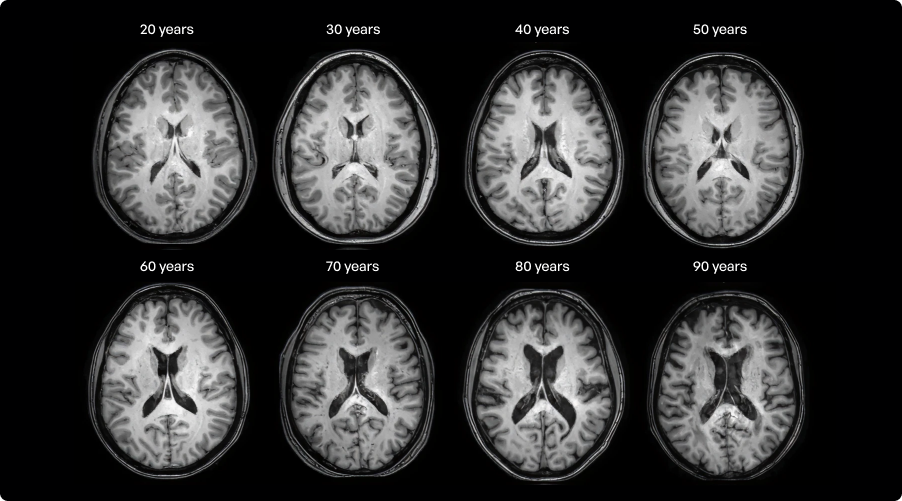 *Reproduced from (Normative Cerebral Perfusion...)
*Reproduced from (Normative Cerebral Perfusion...)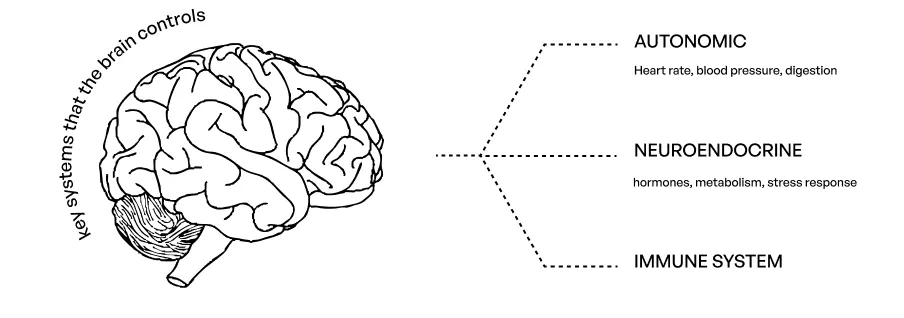
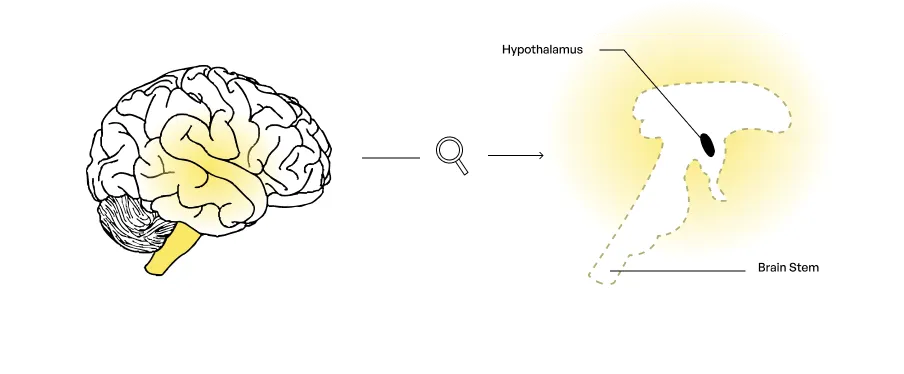
B. The Brain-driven Aging Cycle
The brain needs an uninterrupted supply of blood. Any drops in Cerebral Blood Flow (CBF) could damage key regions of the brain, thereby accelerating aging and further reducing CBF.
- The brain consumes the highest energy per gram of tissue than other organs. Since it cannot store oxygen or glucose, it depends entirely on a steady blood flow.
- The human brain is just 2% of the body’s weight, but 20% of its metabolic load, and 10 times more expensive per gram than muscle. (PNAS | Brain Power).
- The brain is one of the most vascularized organs in the body, receiving approximately 750 ml of blood per minute. (Encyclopedia of Clinical...) This ensures uninterrupted delivery of oxygen and glucose to the neurons. (Neuronal Regulation of...)
- The brain’s reliance on uninterrupted blood flow makes it vulnerable to harm. This is because the brain operates within space constraints and cannot store oxygen or glucose. (Cerebrovascular Blood Flow...)
- The impact of this limitation is heightened due to the high metabolic requirements of neurons. A single cortical neuron uses approximately 4.7 billion ATP per second. (NeuroImage | Quantitative Imaging of...)
- Capillaries in the brain collapse if local blood pressure falls below the minimum value needed to stay open, and this threshold increases with age.
- The minimum internal pressure required to ensure that blood flows within our capillaries and they don’t collapse is called the Critical Closing Pressure (CrCP). Thickening of blood vessels causes CrCP to increase with age. (Impact of age...) (Critical closing pressure...)
- Hypertension in old age often represents the body's attempt to maintain adequate brain perfusion when cerebrovascular function is compromised. (AHA Journals | Is high blood...) (Elevated late-life blood…)
(Wiley | On the regulation…) - Aging-associated hypertension often comes at the expense of blood-brain barrier (BBB) dysfunction, which leads to further neuroinflammation and functional capillary loss. (Neurovascular Aging and...), (Journal of Physiology: Hypertension, Blood-Brain Barrier)
- Neurons must remain close to capillaries for oxygen delivery. As more capillaries fail, neurons around them lose oxygen, start to dysfunction, and eventually die.
- Healthy brain tissue keeps neurons within 12–15 microns of a capillary to ensure availability and optimum delivery of nutrients. (Neuronal Regulation of...)
- During insufficient CBF and reduced oxygen supply, neurons become hyperexcitable. Since their glycolytic reserves are limited, energy failure ensues, ultimately leading to excitotoxic neuronal death. (Mechanisms of spreading...)
- When CBF drops below 18 ml/min per 100 g of tissue, neurons shift to anaerobic metabolism, eventually leading to neuronal death. (Applied cerebral physiology...) The time it takes for neurons to become dysfunctional after any drop in blood flow is a field of active research.
- Brain regions that are at the edges of circulation, such as the brainstem and the hypothalamus, rely on delicate perforating vessels. This makes them vulnerable to reductions in blood flow.
- Watershed zones are regions of the brain at the edges of circulation that are supplied by end-arteries. When overall blood flow drops, these regions are the first to suffer damage. (The pathogenesis of...)
- Basal regions of the brain, such as the brainstem and hypothalamus, rely on delicate perforating vessels. Since these areas control breathing, heartbeat, temperature, and hormone balance, any interruption in their fragile supply can throw the entire body out of balance.
There are specific neuronal populations in these areas that are more vulnerable than others: - Brainstem neurons are particularly vulnerable to shortfalls in blood supply due to their high metabolic activity and reliance on uninterrupted blood flow to maintain vital functions, such as breathing. (Metabolic response of...)
-
CBF reduction might lead to progressive harm to neuronal capacity over a 6-month duration.
(Stroke | Chronic Cerebral Hyperperfusion...) - Damage to neurons in the brainstem and hypothalamus accumulates, leading to neuroendocrine and ANS dysfunction, thereby accelerating aging and further reducing CBF.
- One of the known causes of hypertension is vascular compression on the rostral ventrolateral medulla (RVLM). (Nature | Blood pressure variability...)
- Inflammation in the hypothalamus precedes obesity in rodent models and is also associated with obesity in humans. (Obesity is associated...)
- Hypothalamic Menin regulates systemic aging and cognitive decline. (PLOS Biology Hypothalamic Menin Regulates...)
- Problems with brain blood flow appear before other well-known Alzheimer's markers like amyloid-beta plaques, metabolic dysfunction, and brain atrophy. (Early role of...)
- Sarcopenia, the age-related loss of muscle, is associated with reduced rCBF in critical hubs of the central autonomic network. (Sarcopenia and decline...)
- Disrupted tissue integrity and reduced myelin content within the brainstem have been associated with hypertension. (Nature | Investigating the association...)


| Regions | Function | Supply Vulnerability | Evidence for Selective Hypoperfusion |
|---|---|---|---|
|
NTS
(Brainstem) |
Coordinates autonomic reflexes (heart, lungs, baroreflex). (The nucleus of...) | Located in the watershed zone between the terminal branches of the medullary collateral vessels. (Solitary Tract Nuclei...) | Microinfarcts were found in NTS after global hypoperfusion. (Solitary Tract Nuclei...) Exercise training increases NTS capillary density (rat). (Perfusion of Brain...) |
|
PVN
(Hypothalamus) |
Autonomic & endocrine hub, also dominant relay center for Circadian Rhythm (sympathetic drive, vasopressin, stress). (The Paraventricular Nucleus...) | Fed by small perforating arteries of the anteromedial group. (Deep Cerebral Perforators...) | Microvascular density of the human paraventricular nucleus decreases with aging. (Microvascular density of...) |
|
RVLM
(Brainstem) |
Maintains sympathetic tone & BP. (Rostral Ventrolateral Medulla...) | Supplied by vertebral perforators; no collaterals. (Deep Cerebral Perforators...) | RVLM operates close to the hypoxia threshold in hypertension (Rostral Ventrolateral Medulla...). Lesions of the rostral ventrolateral medulla blunt the cerebrovascular response to hypoxia. (Lesions of the...) |
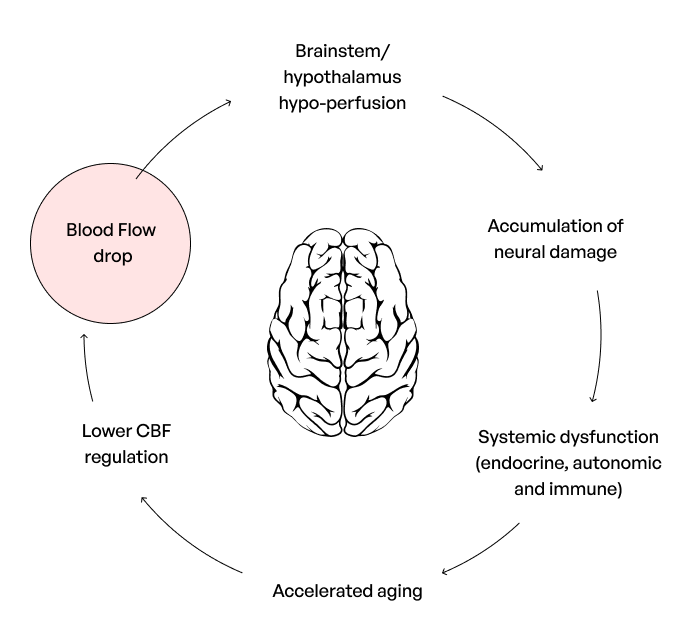
C. The Decline in CBF with Age
CBF declines progressively with age in all individuals. Faster declines are associated with shorter lifespans, making CBF a critical biomarker of healthy aging.
- Cerebral blood flow (CBF) drops by about 20-40% between ages 20 and 80, with low CBF being associated with double the risk of mortality.
- As you age, cerebral blood flow (CBF) drops by about 0.5% yearly. From your 20s to your 80s, that’s a 20–40% decrease. (Cerebral blood flow...) (Cerebral blood flow...)
- Low total cerebral blood flow almost doubles the risk of mortality in older adults, independent of cardiovascular status. (Neurology | Total cerebral blood...)
- Superagers (people who age exceptionally well) and centenarians maintain higher baseline CBF.
- Superagers maintain their CBF, have slower brain shrinkage (1.06%/yr vs 2.24%), and stable circadian rhythms. (Preserved global cerebral...), (JAMA | Healthy lifestyle and...), (Neuroendocrine features in...)
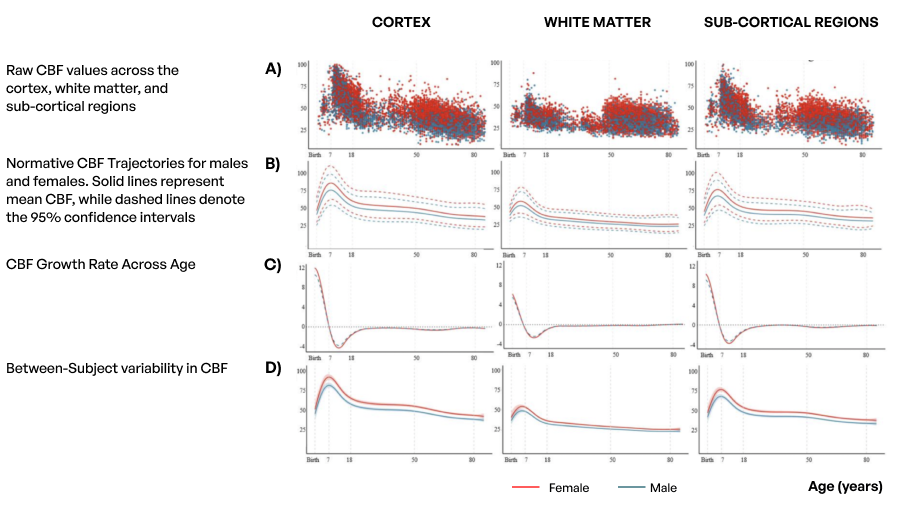 *Reproduced from (Normative Cerebral Perfusion...)
*Reproduced from (Normative Cerebral Perfusion...) *Reproduced from (Neurology | Total cerebral blood...)
*Reproduced from (Neurology | Total cerebral blood...)D. The Role of Gravity
Gravity reduces CBF in an upright posture. Over decades, this chronic underperfusion amplifies the brain-driven aging cycle.
- Gravity affects every organism on Earth. Animals with brains above their hearts must pump blood upwards to counteract gravity.
- Organisms on Earth develop in the constant environment of one unit of gravitational force (1G), and our physiological systems are adapted to that load. Deviations from this can be harmful to our development and physiology. (Gravitational Influence on...)
- Through evolution, physiological mechanisms have developed that counter the impact of gravity:
- Blood pressure is high enough to counter gravity and send blood up to the brain. (Height Matters: re-thinking...)
- Cerebral autoregulation protects against large fluctuations in blood flow to the brain.
(Static autoregulation in...) - Baroreflex adjusts our blood pressure when there are sudden changes to maintain perfusion pressure. (Cardiovascular control from...)
- Muscles aid in venous return by acting as pumps when we walk. (Calf pump activity...)
- Due to the effects of gravity, CBF is significantly lower in upright postures (standing/sitting) than in supine postures.
- We spend 16 hours a day upright, with gravity constantly pulling blood away from the brain.
- Upright postures can result in CBF being reduced by up to 17% when compared to supine positions. (Regional changes in...)
- CSF circulation is significantly reduced (37-50%) in the upright posture compared to the horizontal/supine posture, resulting in less efficient waste clearance during upright activities compared to supine rest. (The impact of...)
- 70% of blood volume in the upright position is located below the heart level in humans, creating sustained pressure on cerebral circulation regulation. (An anthropogenic model...)
- Prolonged sitting can reduce cerebral flow by 3-8% in addition to the reduction upon changing posture from supine to upright. (Impact of acute...) Studies have reported that even 60 minutes of sitting can reduce total CBF. (Regular walking breaks...)
- Standing suddenly can cause a momentary drop in blood pressure of up to 20 mmHg, even in healthy adults, leading to light-headedness. (Initial orthostatic hypotension)
-
There is a linear inverse relationship between CBF and head-to-foot gravitational force.
(The relationship between...) - The brain compensates with autoregulation, but the buffer range is narrow and fluctuations still occur.
-
A 2024 meta-analysis of 143 studies suggested that the effective autoregulation range is only about 20 mmHg (80-100 mmHg MAP), instead of the previously established 50-150 mmHg range.
(Static autoregulation in...), (Losing the dogmatic...) - The brain is 4 times more vulnerable to blood pressure drops (1.47 ± 0.71% in CBF per 1% change in BP) than blood pressure increases. (0.37 ± 0.38% in CBF per 1% change in BP) (Static autoregulation in...)
- It has also been shown that CBF is not constant even within the autoregulation range.
(Losing the dogmatic...) - Autoregulation is impaired with age, leaving old people especially vulnerable. (Age-Related Changes...)
- A study found concurrent decreases in CBFv and MABP from a supine to seated posture, indicative of a system with imperfect static Cerebral Autoregulation even in healthy individuals. (Postural Effects on...)
- Chronic CBF reductions in upright posture may drive progressive and irreversible microvascular damage across the brain, including in the brainstem and hypothalamus.
-
Cerebral capillaries progress from functional rarefaction, when they no longer conduct blood flow, into anatomical rarefaction, when capillaries begin to die and tissue function is severely stunted.
(The life cycle...) - Poor blood flow in microvessels can lead to permanent damage. Decreased shear stress in capillaries can compromise vasodilation, leading to prolonged functional rarefaction and ultimately permanent vessel loss. (Microvascular rarefaction: The...), (Assessment of microvascular...)
- Silent brain infarcts are a sign of ischemic brain damage and are surprisingly common. They are found even in young, healthy individuals and may play an important role in age-related cognitive decline. (Prevalence and risk...), (Silent brain infarcts...), (The epidemiology of...), (Nature | Perspective: Silent, but...)
- A study reported decreased arteriolar and tissue pO₂ with aging, showing that older brains tend to receive less oxygen. After middle age, the capillary network fails to compensate for larger decreases in arterial pO2. (Compromised microvasculature oxygen...)
- Capillary dysfunction or narrowing may cause “micro-ischemia” due to the disrupted flow of blood. Increased oxygen extraction can temporarily compensate for this, but widespread narrowing can cause ischemia. (Capillary Dysfunction: Its...)
- Brainstem hypoperfusion might have a role in sympathetic activity and hypertension with age. (Neurogenic hypertension and...)
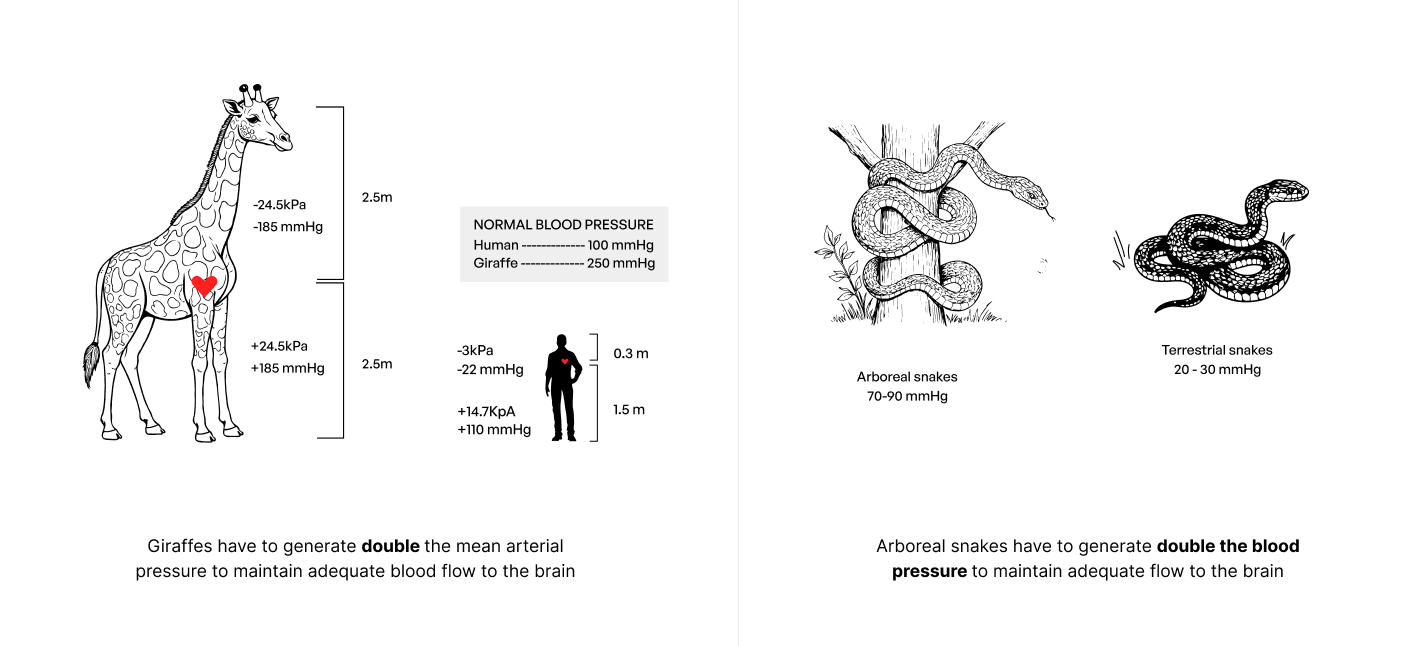
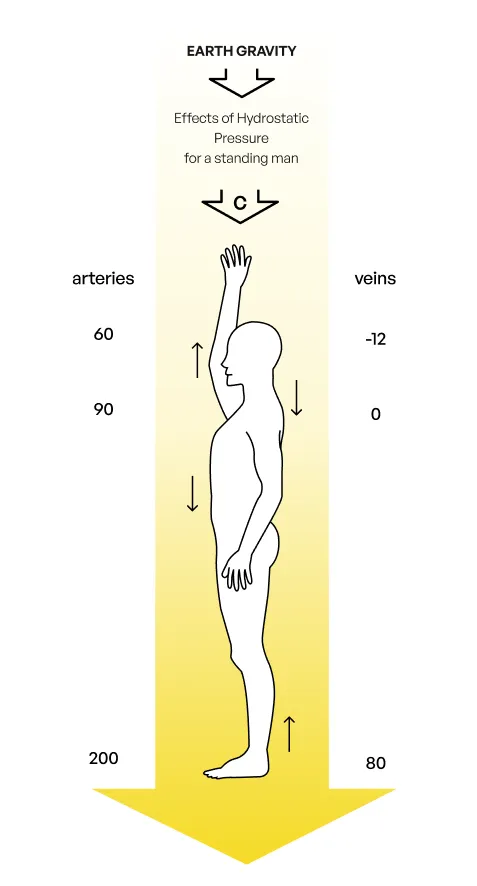
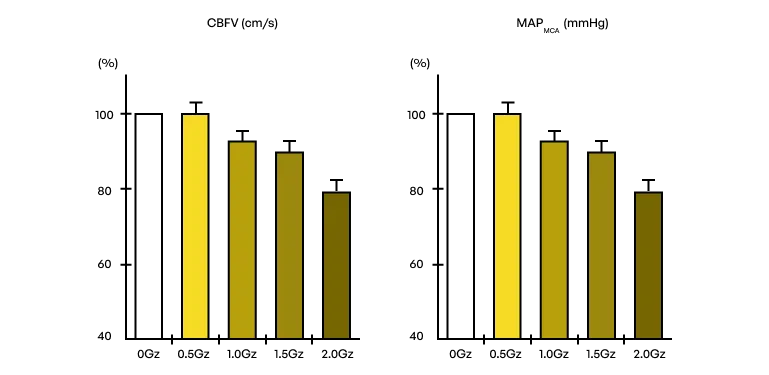 *Reproduced from (The relationship between...)
*Reproduced from (The relationship between...)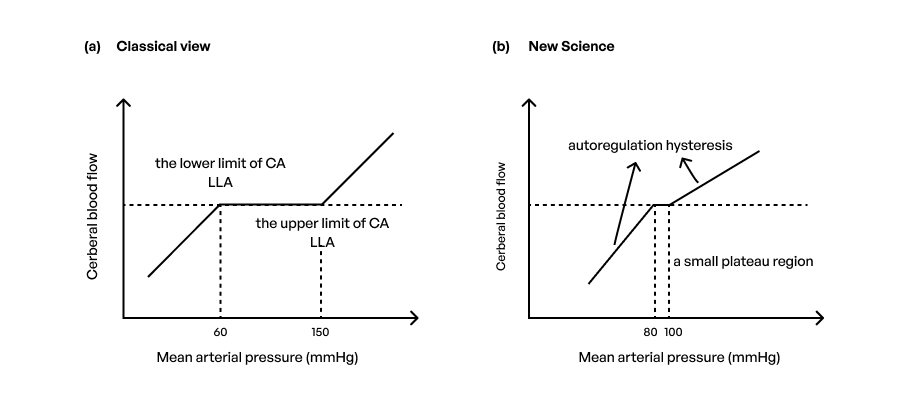 *Reproduced from (Static autoregulation in...)
*Reproduced from (Static autoregulation in...)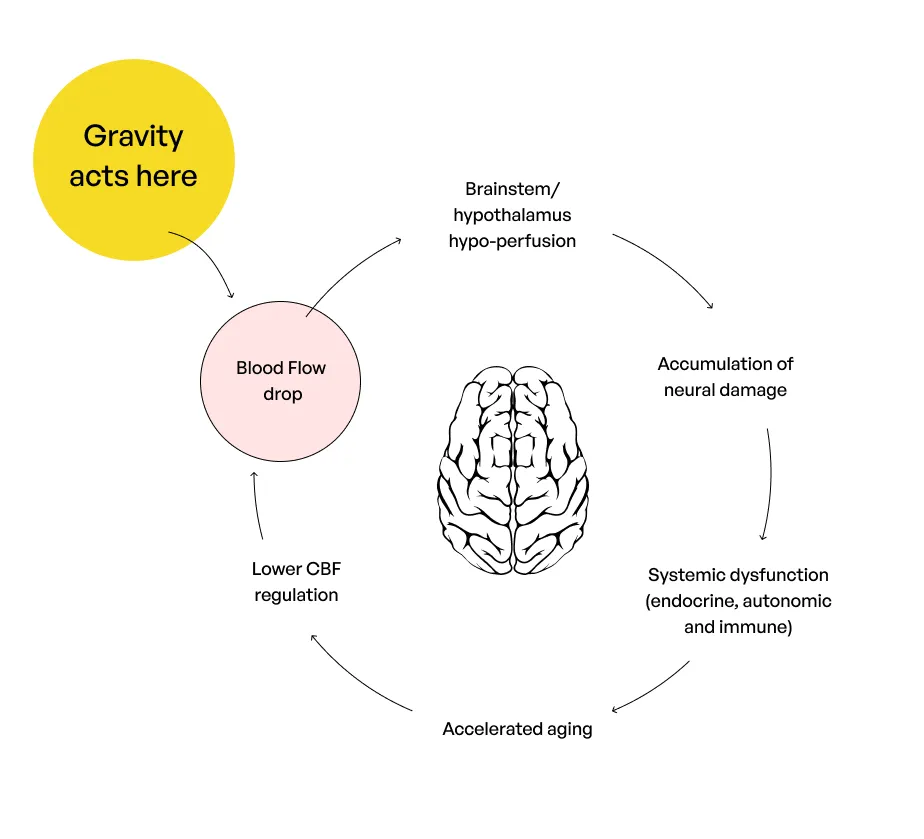
The Hypothesis
- Due to gravity, there is a chronic reduction in brain flow during the approximately 16 hours we spend upright every day.
- Deep brain structures such as the hypothalamus and brainstem, which regulate heart rate, breathing, temperature, hormones, inflammation, and immune response, are especially vulnerable to this cumulative reduction.
- Long-term reduction in blood flow to these areas contributes to neurodegeneration, systemic dysregulation, and faster aging.
E. The Ultimate Biomarker
Optimizing cerebral blood flow (CBF) may be the highest leverage intervention for slowing aging, maintaining cognitive sharpness, and countering the effects of gravity on CBF.
- CBF is strongly linked to focus, productivity, and well-being. This makes CBF a strong predictor of our health and everyday performance.
- Lower total CBF is associated with slower processing speed, weaker executive function, and poorer global cognition. (Total cerebral blood...)
- The magnitude of resting CBF has been associated with cognitive functions. (Cerebral Blood Flow...)
- Even 2% dehydration can result in impaired performance in attention, psychomotor, and short-term memory tasks. (Cognitive performance and...)
- Many healthy habits, such as an active lifestyle, a balanced diet, and sufficient sleep, enhance CBF and promote longevity.
- Reductions in CBF due to uninterrupted sitting may equate to 2-4 years of age-related decline, and even a 2-minute walking break can counter this decline. (Regular walking breaks...)
- Diets rich in nitrates and flavonoids (Dietary nitrate modulates...), (The effect of...), as well as diets such as the ketogenic diet (Regional cerebral effects...), have also been shown to increase CBF.
- Lack of sleep is shown to be detrimental to CBF in the long run. (Sleep deprivation impairs...), (Regional cerebral hypoperfusion...)
- Activities such as aerobic, resistance, and high-intensity exercise, as well as yoga, inversions, and breathwork, enhance the brain’s perfusion.
- Aerobic exercise boosts CBF acutely, and physical activity can help maintain it (After reaching retirement...), (One-year aerobic exercise...)
- Repeated challenges of breath-holding induced an overall rise in rCBF. Acute rCBF increases ranged from 47% to 87%. (Cerebral blood flow...)
- The book “Light on Yoga” lists 200+ yoga poses, of which ~50% position the head below the heart (Light on Yoga), potentially causing a temporary spike in CBF.
-
Measuring real-time CBF in 6 healthy adults using an experimental proxy device revealed that passive inversions (using an inversion table) caused an even greater spike in CBF than active inversions (handstand). On average, handstands increased CBF by 13%*, whereas passive inversion increased CBF by 20%*
*Measured using an experimental proxy device - Emerging anti-gravity interventions not only increase CBF acutely but also show promising longitudinal impact.
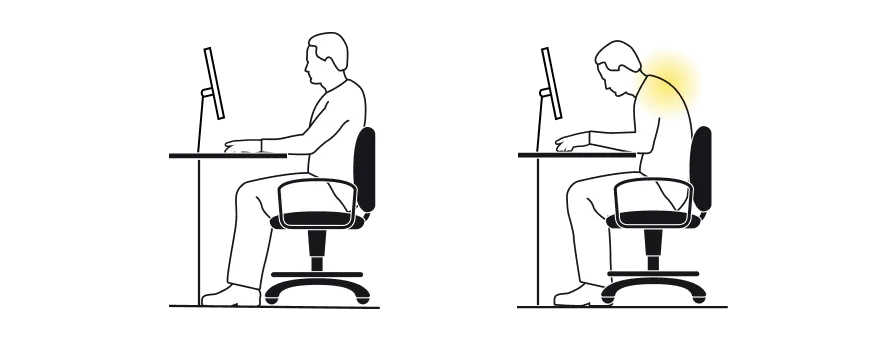

We measured CBF for 10 participants over 40 days (averaging them into 4 buckets of 10 days) and made them perform 10-20 minutes of passive inversion 4 times a week. Nine out of ten participants experienced an improvement in baseline CBF, with a statistically significant average increase of 7%* over 40 days.
*Measured using an experimental proxy device
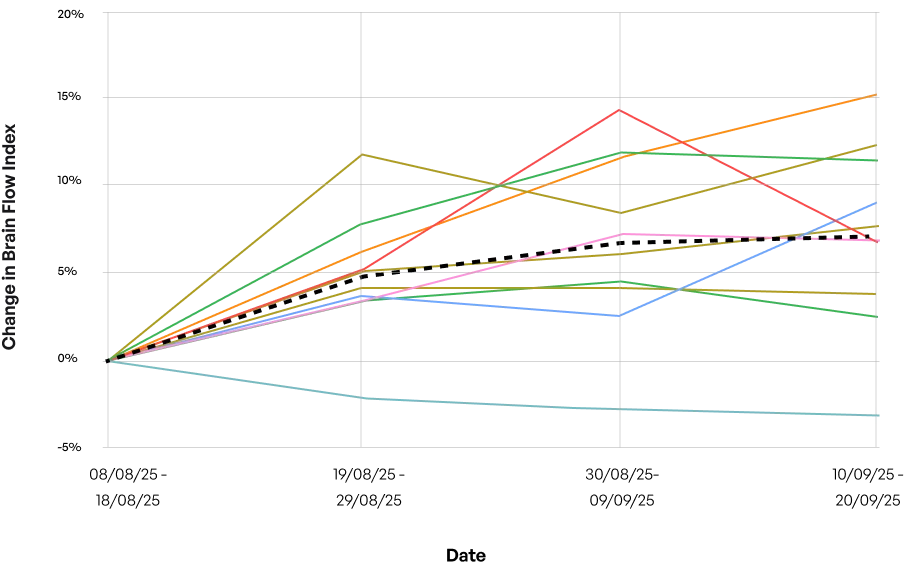
More interventions to increase CBF and Longevity are being popularised among wellness enthusiasts and longevity researchers. Read more at CBF Cheatsheet.
Disclaimer: The views expressed are the author’s alone and are for informational purposes only. Do your own research and draw your own conclusions. This is not medical advice, and the author makes no medical claims. Always consult a qualified physician before changing your lifestyle or attempting any intervention.